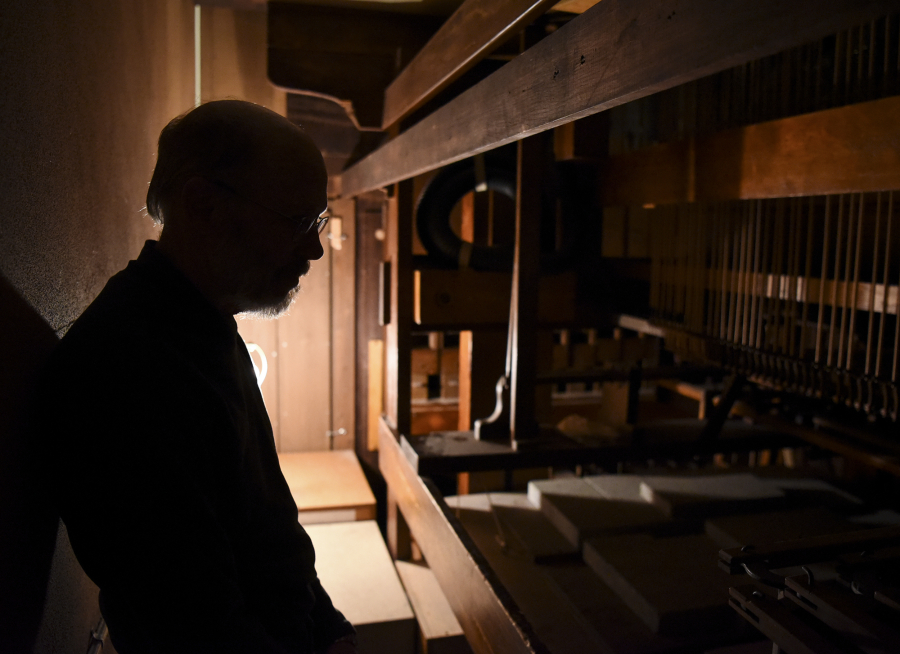There have been a few transitions for a Vancouver church organ, including electrical power, since it was built in 1890.
After its most recent upgrade, the 127-year-old musical instrument rates a trumpet fanfare — which now can be played on the organ.
Portland organ builder Richard Bond just finished installing a new trumpet stop in the organ at St. Luke’s ~ San Lucas Episcopal Church.
It’s the latest chapter in a relationship that goes way back, in years as well as miles. Bond went back to Rhode Island in 1983 to load the organ onto a rental truck and haul it cross-country to his shop in Portland.
That was almost a century after the organ was built by W.K. Adams in Providence, R.I. (Adams’ first initial, by the way stood for “Welcome.”)
On Saturday, the organ will be in full voice — and that’s not just a figure of speech, church music director Tim Nickel said.
Guest organist Paul Tegels, an associate music professor at Pacific Lutheran University in Tacoma, will play a recital as part of a rededication ceremony.
A pipe organ “is a breathing instrument,” Nickel said. “Air flowing through its pipes is like a human voice, which makes it so suitable for hymns.”
The recent project was a replacement rather than an addition, Bond said. The organ builder and his staff removed a stop that wasn’t getting a lot of use and replaced it with a trumpet effect.
Not plug-and-play
“A Bourdon stop has a low-pitched, soft sound,” Bond said. “In the Episcopal Church, there are processions and a certain amount of pageantry, and that’s what trumpets are good at.”
It wasn’t just a plug-and-play process.
“The bourdon stop has 46 pipes. The trumpet has 58, one pipe for each note. We had to drill 12 more holes,” Bond said.
The project was funded by a gift from the estate of congregation member Dolores Barber, who died on Dec. 31, 2015.
It’s the latest chapter in a musical career that started in Notre Dame Catholic Church in Central Falls, R.I. In 1890, air for the organ pipes was provided by people pumping bellows.
“You don’t start seeing electrical blowers until the early years of the 20th century,” Bond said. “We often install backup hand bellows in case of power failure. In two cases, they have been used because of power failure.”
As the Notre Dame congregation grew smaller and poorer over the decades, the W.K. Adams pipe organ fell silent.
Then a musical matchmaker stepped in. The nonprofit Organ Clearing House links churches in the market for an organ with congregations that have one to spare.
Coal-mine conditions
A history of the organ written by Pat McHargue and Mary Whyte for a 1990 centennial concert described the moving process. It was a 100-degree day on July 4, 1983, when Bond and five other men took the organ apart. Notre Dame had been heated by a coal-fired furnace, leaving a layer of coal dust on the unused organ.
The work “soon rendered the perspiring men as dirty as coal miners,” McHargue and Whyte wrote. “The larger pieces had to be lowered by ropes very carefully over the railing of the choir loft to the main floor of the church, fifty feet below.”
Bond and his assistants started installing the organ at St. Luke’s ~ San Lucas in 1984. It’s a sizable musical instrument, with more than 1,000 individual pipes. It’s encased by a cabinet that measures about 10 feet by 14 feet.
That size was a factor in an earlier artistic project. A rose window by French glass artist Gabriel Loire was installed in the west wall of the sanctuary in 1968. Even though the church wouldn’t have its organ for 16 years, the window was installed high enough above the choir loft so that the pipes wouldn’t be in the way.




